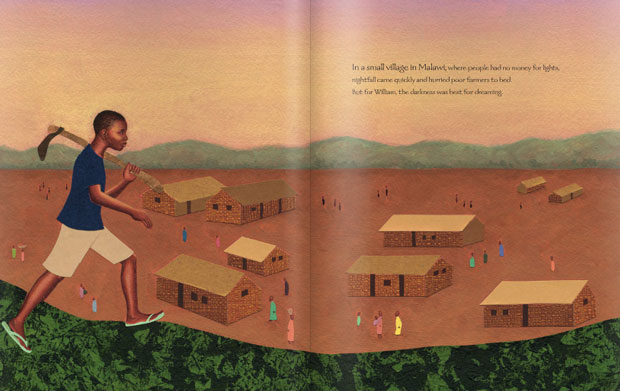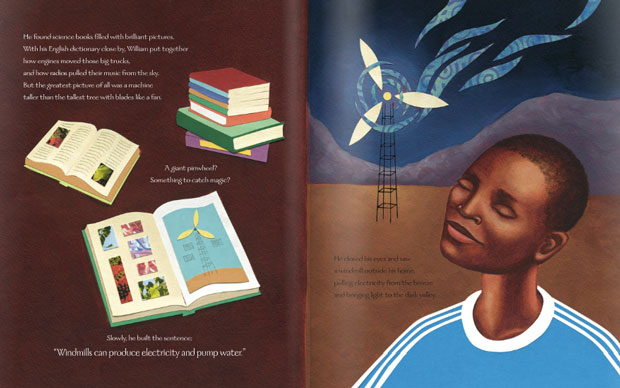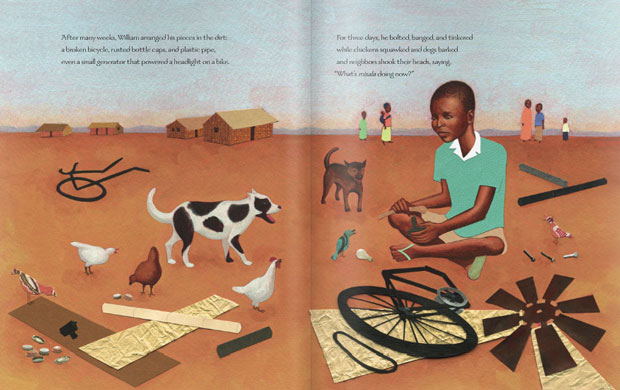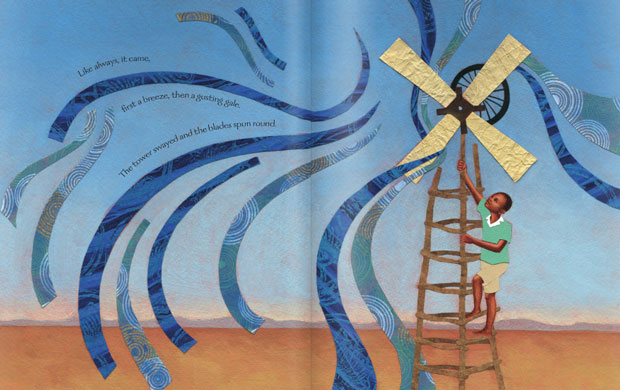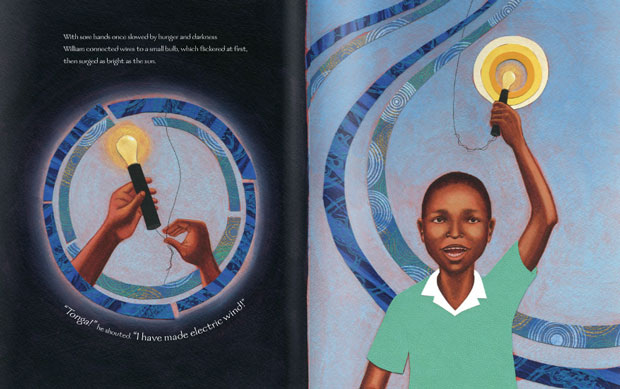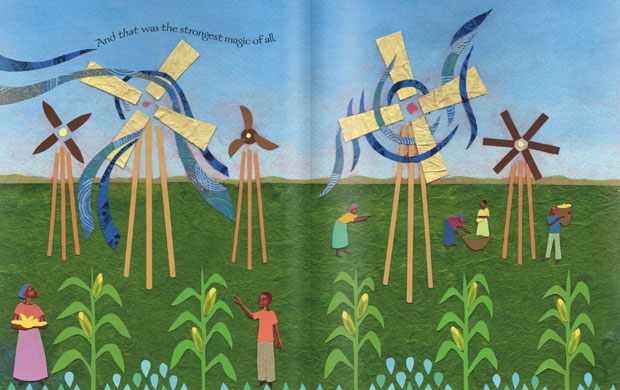The Boy Who Harnessed the Wind
Read it: 'The Boy Who Harnessed the Wind' teaches perseverance
The Boy Who Harnessed the Wind
by William Kamkwamba and Bryan Mealer, illustrated by Elizabeth Zunon
Dial, $16.99; ages 7-9
What it's about: This is the inspiring true story of William Kamkwamba, a boy with big dreams who built a windmill from junkyard scraps in order to help feed his village. William always dreamt of magic -- the magic of Ghost Dancers and witch planes, but also of the magic that made radios play music and trucks rumble by the fields his family farmed. When famine hits their village, William is forced to drop out of school and eat only one meal a day. Undeterred, he studies science books from the library and learns how to unlock the magic of a windmill, a magic so strong that it will help him feed his people.
Why read it: Readers are introduced to the culture of Malawi and see what it is like to live in a country very different than their own. The main character is a boy full of curiosity and can-do spirit who persevered even when people said he was crazy. Children see that hard work pays off and learn the importance in believing in their dreams. The illustrations are worthy of this empowering and hopeful tale, rich and warm and accented with cut-paper collage details. It's an inspiring story of courage in the face of hardship, and ingenuity with limited resources.
-- Sarai Brinker, Special to the Star-Telegram
William Kamkwamba was born in Malawi, a country where magic ruled and modern science was mystery. It was also a land withered by drought and hunger, and a place where hope and opportunity were hard to find. But William had read about windmills in a book called Using Energy, and he dreamed of building one that would bring electricity and water to his village and change his life and the lives of those around him. His neighbors may have mocked him and called him misala—crazy—but William was determined to show them what a little grit and ingenuity could do.
Enchanted by the workings of electricity as a boy, William had a goal to study science in Malawi's top boarding schools. But in 2002, his country was stricken with a famine that left his family's farm devastated and his parents destitute. Unable to pay the eighty-dollar-a-year tuition for his education, William was forced to drop out and help his family forage for food as thousands across the country starved and died.
Yet William refused to let go of his dreams. With nothing more than a fistful of cornmeal in his stomach, a small pile of once-forgotten science textbooks, and an armory of curiosity and determination, he embarked on a daring plan to bring his family a set of luxuries that only two percent of Malawians could afford and what the West considers a necessity—electricity and running water. Using scrap metal, tractor parts, and bicycle halves, William forged a crude yet operable windmill, an unlikely contraption and small miracle that eventually powered four lights, complete with homemade switches and a circuit breaker made from nails and wire. A second machine turned a water pump that could battle the drought and famine that loomed with every season.
Soon, news of William's magetsi a mphepo—his "electric wind"—spread beyond the borders of his home, and the boy who was once called crazy became an inspiration to those around the world.
Here is the remarkable story about human inventiveness and its power to overcome crippling adversity. The Boy Who Harnessed the Wind will inspire anyone who doubts the power of one individual's ability to change his community and better the lives of those around him.
A Story of Passion and Possibility
by Maria Popova
What bamboo poles and bicycle chains have to do with sparking the spirit of entrepreneurship.
 When he was only 14 years old, William Kamkwamba dreamt up a windmill that would produce electricity for his village in Malawi. The trouble? As Malawi was experiencing the worst famine in 50 years, William had to drop out of school because his family could no longer afford the $80 annual tuition. This meant he not only had no money to purchase the parts, but also no formal education to teach him how to put them together. Determined, he headed to the local library and voraciously devoured its limited selection of textbooks, then gathered some scrap parts — a bicycle dynamo, bamboo poles, a tractor fan, rubber belts, a bike chain ring — and brought his vision to life, building a functioning windmill. He spent the next five years perfecting the design and went on to found theMoving Windmills Project in 2008 to foster rural economic development and education projects in Malawi.
When he was only 14 years old, William Kamkwamba dreamt up a windmill that would produce electricity for his village in Malawi. The trouble? As Malawi was experiencing the worst famine in 50 years, William had to drop out of school because his family could no longer afford the $80 annual tuition. This meant he not only had no money to purchase the parts, but also no formal education to teach him how to put them together. Determined, he headed to the local library and voraciously devoured its limited selection of textbooks, then gathered some scrap parts — a bicycle dynamo, bamboo poles, a tractor fan, rubber belts, a bike chain ring — and brought his vision to life, building a functioning windmill. He spent the next five years perfecting the design and went on to found theMoving Windmills Project in 2008 to foster rural economic development and education projects in Malawi.
In 2009, Kamkwamba shared his moving story of perseverance, curiosity, and ingenuity in the memoir The Boy Who Harnessed the Wind: Creating Currents of Electricity and Hope. Now, this modern-day entrepreneurial fairy tale is being adapted for young hearts and minds in the beautifully illustrated children’s bookThe Boy Who Harnessed the Wind: Young Readers Edition. Kamkwamba’s story shines with all the more optimism and tenacity in the hands of 27-year-old artistElizabeth Zunon, whose rich, lyrical, almost three-dimensional oil-and-cut-paper illustrations, reminiscent of Sophie Blackall’s, vibrate with exceptional whimsy and buoyancy.
Coupled with the launch is a wonderful literacy effort — for every book parents, teacher, and children read online on We Give Books, the Wimbe community lending library, where Kamkwamba’s journey began, gets a new book, up to 10,000. Despite serving some 1,500 pupils, the library currently has no picture books.
Beautiful, moving, and immensely inspirational, The Boy Who Harnessed the Wind: Young Readers Edition tells the kind of story that helps budding entrepreneurs relate to the world through a lens of infinite possibility — the kind of message that might, just might, empower them to harness if not the wind the future itself.
William Kamkwamba: How I harnessed the wind

At age 14, in poverty and famine, a Malawian boy built a windmill to power his family's home. Now at 22, William Kamkwamba, who speaks at TED, here, for the second time, shares in his own words the moving tale of invention that changed his life.
To power his family's home, young William Kamkwamba built an electricity-producing windmill from spare parts and scrap -- starting him on a journey detailed in the book "The Boy Who Harnessed the Wind" and the new film, "William and the Windmill." Full bio »

